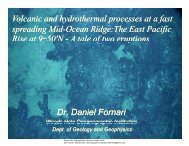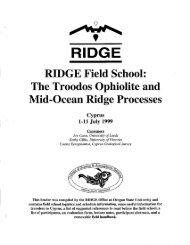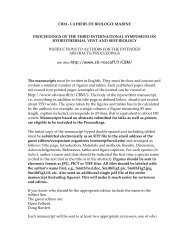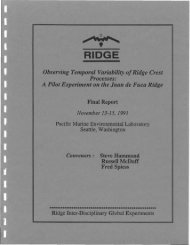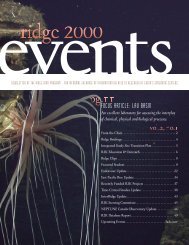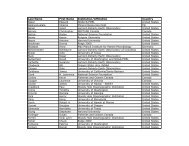You also want an ePaper? Increase the reach of your titles
YUMPU automatically turns print PDFs into web optimized ePapers that Google loves.
Evolution can be examined by studies of on-going processes<br />
and by analysis of present patter~s in vie~ of hi~torical<br />
events. Extension of the populatIon genetIc studIes to<br />
comparisons on the species level will reveal taxonomic<br />
affinities. Smaller scales of evolution can be identified from<br />
community comparisons between separate segments of a ridge.<br />
Identification of major discontinuities in vent community<br />
composition along or among ridges should allow recognition of<br />
geographic centers of evolution. Fundamental geological<br />
differences among ridges, such as spreading rates, should be<br />
examined in terms of species diversity and adaptions in response<br />
to varying geochemical patterns. Communities in other deep-sea<br />
habitats dependent upon chemosynthetic energy are composed of<br />
different species; they may yield clues to the evolutionary<br />
origin of hydrothermal vent species. Analysis of fossil vent<br />
species in sulfides will give direct evidence of past<br />
evolutionary steps. Sedimented hydrothermal systems may<br />
preserve evidence for relationships between chemistry, bacteria,<br />
and animals.<br />
Specific data requirements include information from geology<br />
and geophysics on past ridge morphology and rifting history to<br />
identify times and methods of isolation. Parallel evolutionary<br />
adaptions to the vent habitat can be identified by comparisons<br />
of systematics and physiology. Traditional and genetic techniques<br />
should be employed in erection of animal phylogenies. A<br />
key technique to aid these studies is the refinement of<br />
mechanisms to identify the genetic differentiation in a variety<br />
of organisms.<br />
Plume Studies<br />
How do hydrothermal plumes contribute to the total biological<br />
productivity associated with vent and other benthic<br />
environments?<br />
Extensive plumes associated with hot vent systems represent<br />
the vertical and horizontal component of hydrothermally derived<br />
biologically important energy sources. These energy sources<br />
support a chemosynthesis based food chain, the significance of<br />
which is not known. The importance of plume systems as a source<br />
of chemosynthetically fixed carbon, and the fate of this organic<br />
carbon needs study. Species composition and feeding rates of<br />
zooplankton consuming plume bacteria and the role, if any,<br />
plumes have on the dispersal and nutrition of vent animal larvae<br />
are critical to understanding this system.<br />
50






